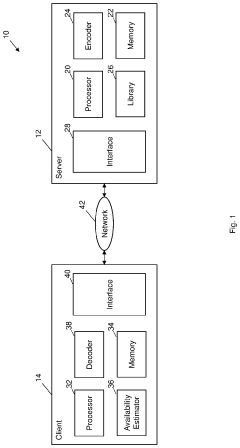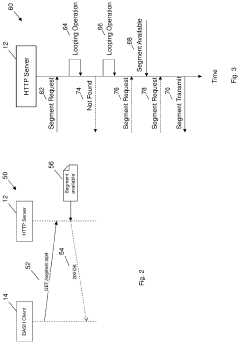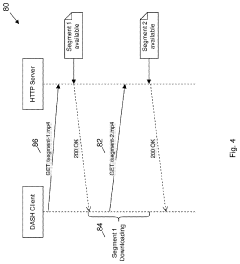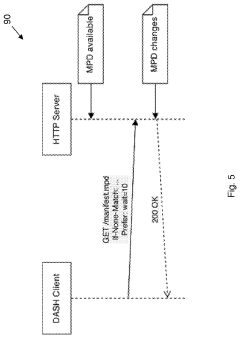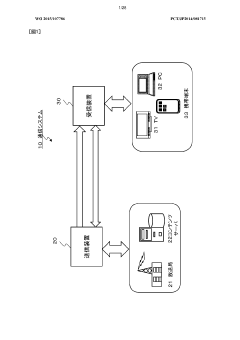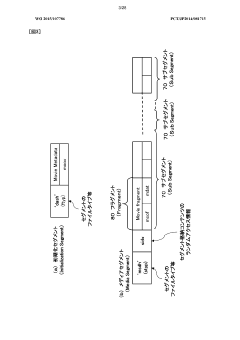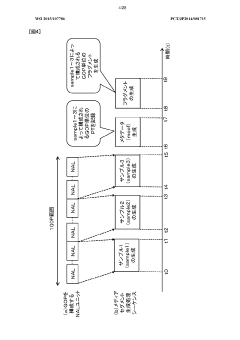How to Implement LDAC in Streaming Services?
JUL 4, 20259 MIN READ
Generate Your Research Report Instantly with AI Agent
Patsnap Eureka helps you evaluate technical feasibility & market potential.
LDAC Technology Overview
LDAC (Low Latency Audio Codec) is a high-resolution audio coding technology developed by Sony Corporation. It is designed to deliver high-quality audio over Bluetooth connections, addressing the limitations of previous Bluetooth audio codecs. LDAC supports up to 24-bit/96kHz audio transmission at a maximum bitrate of 990 kbps, significantly higher than the standard SBC (Subband Coding) codec used in most Bluetooth devices.
The technology utilizes adaptive bit rate allocation and efficient data compression techniques to maximize audio quality while maintaining low latency. LDAC employs a psychoacoustic model to optimize the encoding process, focusing on preserving the most perceptually important audio information. This approach allows for a more faithful reproduction of the original audio signal, especially in the high-frequency range.
LDAC operates in three modes: 330 kbps, 660 kbps, and 990 kbps. The codec dynamically switches between these modes based on the available bandwidth and connection stability, ensuring optimal performance under varying conditions. This adaptive nature makes LDAC particularly suitable for mobile devices and wireless audio streaming applications.
One of the key features of LDAC is its ability to maintain a wide frequency range up to 40 kHz, which is essential for high-resolution audio playback. This capability sets LDAC apart from many other Bluetooth audio codecs, which often struggle to reproduce frequencies above 20 kHz accurately.
In terms of implementation, LDAC requires hardware support on both the transmitting and receiving devices. It has been integrated into the Android operating system since version 8.0 (Oreo), making it widely available on many modern smartphones and tablets. However, for optimal performance, audio equipment manufacturers need to license and implement LDAC in their products.
The adoption of LDAC in streaming services presents both opportunities and challenges. While it offers superior audio quality for compatible devices, its implementation requires careful consideration of bandwidth requirements, device compatibility, and potential licensing costs. Streaming services must balance these factors against the potential benefits of offering high-resolution audio to their users.
As the demand for high-quality audio streaming continues to grow, LDAC technology is positioned to play a significant role in shaping the future of wireless audio transmission. Its ability to deliver near-lossless audio quality over Bluetooth connections makes it an attractive option for audiophiles and casual listeners alike, potentially influencing the development of future audio streaming technologies and standards.
The technology utilizes adaptive bit rate allocation and efficient data compression techniques to maximize audio quality while maintaining low latency. LDAC employs a psychoacoustic model to optimize the encoding process, focusing on preserving the most perceptually important audio information. This approach allows for a more faithful reproduction of the original audio signal, especially in the high-frequency range.
LDAC operates in three modes: 330 kbps, 660 kbps, and 990 kbps. The codec dynamically switches between these modes based on the available bandwidth and connection stability, ensuring optimal performance under varying conditions. This adaptive nature makes LDAC particularly suitable for mobile devices and wireless audio streaming applications.
One of the key features of LDAC is its ability to maintain a wide frequency range up to 40 kHz, which is essential for high-resolution audio playback. This capability sets LDAC apart from many other Bluetooth audio codecs, which often struggle to reproduce frequencies above 20 kHz accurately.
In terms of implementation, LDAC requires hardware support on both the transmitting and receiving devices. It has been integrated into the Android operating system since version 8.0 (Oreo), making it widely available on many modern smartphones and tablets. However, for optimal performance, audio equipment manufacturers need to license and implement LDAC in their products.
The adoption of LDAC in streaming services presents both opportunities and challenges. While it offers superior audio quality for compatible devices, its implementation requires careful consideration of bandwidth requirements, device compatibility, and potential licensing costs. Streaming services must balance these factors against the potential benefits of offering high-resolution audio to their users.
As the demand for high-quality audio streaming continues to grow, LDAC technology is positioned to play a significant role in shaping the future of wireless audio transmission. Its ability to deliver near-lossless audio quality over Bluetooth connections makes it an attractive option for audiophiles and casual listeners alike, potentially influencing the development of future audio streaming technologies and standards.
Streaming Market Analysis
The streaming market has experienced exponential growth in recent years, driven by technological advancements and changing consumer preferences. This market encompasses various forms of digital content delivery, including audio and video streaming services. The global streaming market size was valued at $372.1 billion in 2021 and is projected to reach $1,690.35 billion by 2029, growing at a CAGR of 20.9% during the forecast period.
Audio streaming, in particular, has seen significant expansion, with the rise of music streaming platforms and podcasts. The global music streaming market alone was valued at $29.45 billion in 2021 and is expected to grow at a CAGR of 14.7% from 2022 to 2030. This growth is fueled by factors such as increasing smartphone penetration, improved internet connectivity, and the shift from ownership to access-based music consumption models.
The streaming market is characterized by intense competition among major players like Spotify, Apple Music, Amazon Music, and Tidal. These companies are constantly innovating to differentiate themselves and attract subscribers. One key area of focus is audio quality, with high-fidelity audio becoming a significant selling point for premium subscribers.
In this context, the implementation of advanced audio codecs like LDAC in streaming services becomes crucial. LDAC, developed by Sony, offers high-resolution audio transmission over Bluetooth, supporting up to 990 kbps at 24 bit/96 kHz. This technology addresses the growing demand for superior audio quality in streaming services, particularly among audiophiles and music enthusiasts.
The market analysis reveals a clear trend towards higher quality audio streaming. According to a survey by MusicWatch, 64% of music subscribers are willing to pay more for better sound quality. This presents a significant opportunity for streaming services to implement LDAC and similar high-quality audio technologies to capture this segment of the market.
However, challenges remain in the widespread adoption of LDAC in streaming services. These include the need for compatible hardware, potential bandwidth limitations, and the balance between audio quality and data consumption. Despite these challenges, the market trends indicate a growing appetite for high-quality audio streaming, making LDAC implementation a potentially valuable strategy for streaming services looking to differentiate themselves and cater to discerning listeners.
Audio streaming, in particular, has seen significant expansion, with the rise of music streaming platforms and podcasts. The global music streaming market alone was valued at $29.45 billion in 2021 and is expected to grow at a CAGR of 14.7% from 2022 to 2030. This growth is fueled by factors such as increasing smartphone penetration, improved internet connectivity, and the shift from ownership to access-based music consumption models.
The streaming market is characterized by intense competition among major players like Spotify, Apple Music, Amazon Music, and Tidal. These companies are constantly innovating to differentiate themselves and attract subscribers. One key area of focus is audio quality, with high-fidelity audio becoming a significant selling point for premium subscribers.
In this context, the implementation of advanced audio codecs like LDAC in streaming services becomes crucial. LDAC, developed by Sony, offers high-resolution audio transmission over Bluetooth, supporting up to 990 kbps at 24 bit/96 kHz. This technology addresses the growing demand for superior audio quality in streaming services, particularly among audiophiles and music enthusiasts.
The market analysis reveals a clear trend towards higher quality audio streaming. According to a survey by MusicWatch, 64% of music subscribers are willing to pay more for better sound quality. This presents a significant opportunity for streaming services to implement LDAC and similar high-quality audio technologies to capture this segment of the market.
However, challenges remain in the widespread adoption of LDAC in streaming services. These include the need for compatible hardware, potential bandwidth limitations, and the balance between audio quality and data consumption. Despite these challenges, the market trends indicate a growing appetite for high-quality audio streaming, making LDAC implementation a potentially valuable strategy for streaming services looking to differentiate themselves and cater to discerning listeners.
LDAC Implementation Challenges
Implementing LDAC (Low Latency Audio Codec) in streaming services presents several significant challenges that developers and service providers must address. One of the primary obstacles is the increased computational complexity required for real-time encoding and decoding of high-quality audio streams. LDAC's advanced algorithms demand more processing power compared to traditional codecs, potentially straining server resources and client devices.
Bandwidth management poses another critical challenge. While LDAC offers superior audio quality, it also requires higher bitrates compared to some other Bluetooth codecs. Streaming services must carefully balance audio quality with data consumption, especially for users with limited internet connections or data plans. This necessitates the implementation of adaptive bitrate streaming techniques specifically tailored for LDAC.
Compatibility issues across different devices and platforms represent a significant hurdle. Not all smartphones, tablets, or audio equipment support LDAC, which can lead to fragmented user experiences. Streaming services need to implement fallback mechanisms to ensure seamless playback on non-LDAC devices without compromising the overall service quality.
Latency management is crucial for maintaining synchronization between audio and video content, particularly in live streaming scenarios. LDAC's low latency capabilities must be carefully integrated into existing streaming infrastructures to minimize buffering and ensure precise timing across various network conditions.
The licensing and royalty structure associated with LDAC technology can be complex for streaming services to navigate. Implementing LDAC may require negotiating agreements with Sony, the technology's developer, which can impact the cost structure and potentially limit widespread adoption.
Quality assurance and testing processes become more intricate with LDAC implementation. Streaming services must develop comprehensive testing protocols to ensure consistent audio quality across a wide range of devices, network conditions, and content types. This includes verifying the codec's performance in challenging scenarios such as network fluctuations or device switching.
Integration with existing content management systems and audio processing pipelines presents another challenge. Streaming services often have established workflows for encoding, storing, and delivering audio content. Incorporating LDAC into these systems may require significant modifications to backend infrastructure and content preparation processes.
Lastly, user education and interface design considerations are essential for successful LDAC implementation. Streaming services must effectively communicate the benefits of LDAC to users and provide intuitive controls for enabling or adjusting the codec's settings. This includes developing clear visual indicators for LDAC-enabled playback and offering guidance on compatible devices and optimal listening conditions.
Bandwidth management poses another critical challenge. While LDAC offers superior audio quality, it also requires higher bitrates compared to some other Bluetooth codecs. Streaming services must carefully balance audio quality with data consumption, especially for users with limited internet connections or data plans. This necessitates the implementation of adaptive bitrate streaming techniques specifically tailored for LDAC.
Compatibility issues across different devices and platforms represent a significant hurdle. Not all smartphones, tablets, or audio equipment support LDAC, which can lead to fragmented user experiences. Streaming services need to implement fallback mechanisms to ensure seamless playback on non-LDAC devices without compromising the overall service quality.
Latency management is crucial for maintaining synchronization between audio and video content, particularly in live streaming scenarios. LDAC's low latency capabilities must be carefully integrated into existing streaming infrastructures to minimize buffering and ensure precise timing across various network conditions.
The licensing and royalty structure associated with LDAC technology can be complex for streaming services to navigate. Implementing LDAC may require negotiating agreements with Sony, the technology's developer, which can impact the cost structure and potentially limit widespread adoption.
Quality assurance and testing processes become more intricate with LDAC implementation. Streaming services must develop comprehensive testing protocols to ensure consistent audio quality across a wide range of devices, network conditions, and content types. This includes verifying the codec's performance in challenging scenarios such as network fluctuations or device switching.
Integration with existing content management systems and audio processing pipelines presents another challenge. Streaming services often have established workflows for encoding, storing, and delivering audio content. Incorporating LDAC into these systems may require significant modifications to backend infrastructure and content preparation processes.
Lastly, user education and interface design considerations are essential for successful LDAC implementation. Streaming services must effectively communicate the benefits of LDAC to users and provide intuitive controls for enabling or adjusting the codec's settings. This includes developing clear visual indicators for LDAC-enabled playback and offering guidance on compatible devices and optimal listening conditions.
Current LDAC Integration Solutions
01 Audio codec technology for wireless devices
LDAC is an advanced audio codec technology developed for high-quality wireless audio transmission. It enables the transmission of high-resolution audio data over Bluetooth connections, offering improved sound quality compared to standard Bluetooth codecs. LDAC supports higher bitrates and a wider frequency range, resulting in a more detailed and immersive audio experience for users of compatible devices.- LDAC audio codec implementation: LDAC is a high-quality audio codec developed for Bluetooth audio transmission. It allows for higher bitrates and better audio quality compared to standard Bluetooth codecs. Implementation of LDAC in audio devices can significantly improve wireless audio performance.
- LDAC integration in audio systems: Integration of LDAC technology into various audio systems, including smartphones, headphones, and speakers. This involves hardware and software modifications to support the LDAC codec, enabling high-resolution audio streaming over Bluetooth connections.
- LDAC compatibility with other audio technologies: Ensuring compatibility between LDAC and other audio technologies, such as aptX and AAC. This includes developing methods for seamless switching between codecs based on device capabilities and connection quality, as well as optimizing performance across different platforms.
- LDAC power efficiency improvements: Developing techniques to improve power efficiency in LDAC-enabled devices. This involves optimizing encoding and decoding processes, implementing power-saving modes, and enhancing battery life for wireless audio devices using the LDAC codec.
- LDAC application in IoT and smart devices: Expanding the use of LDAC technology beyond traditional audio devices to Internet of Things (IoT) and smart devices. This includes implementing LDAC in smart home systems, wearables, and other connected devices to enhance audio quality in various applications.
02 Integration with smart home and IoT devices
LDAC technology is being integrated into various smart home and Internet of Things (IoT) devices to enhance audio streaming capabilities. This integration allows for improved audio quality in wireless speakers, soundbars, and other connected audio devices within smart home ecosystems. The technology enables seamless high-quality audio streaming across multiple devices, enhancing the overall user experience in smart homes.Expand Specific Solutions03 Application in mobile devices and wearables
LDAC is increasingly being implemented in mobile devices such as smartphones and tablets, as well as wearable technology like wireless earbuds and smartwatches. This implementation allows for high-quality audio streaming directly from these devices, enhancing the audio experience for users on-the-go. The technology is particularly beneficial for music streaming services and mobile gaming applications that require superior audio quality.Expand Specific Solutions04 Compatibility with automotive audio systems
LDAC technology is being adapted for use in automotive audio systems to provide enhanced in-car entertainment experiences. This adaptation allows for high-quality wireless audio streaming from mobile devices to car audio systems, improving the overall sound quality and reducing latency. The technology is particularly useful for integrating smartphone audio with in-car infotainment systems.Expand Specific Solutions05 Energy efficiency improvements
Ongoing developments in LDAC technology focus on improving energy efficiency to extend battery life in wireless audio devices. These improvements aim to optimize the power consumption of LDAC-enabled devices while maintaining high audio quality. This is particularly important for small form-factor devices like true wireless earbuds and portable speakers, where battery life is a critical factor.Expand Specific Solutions
Key Players in LDAC Ecosystem
The implementation of LDAC in streaming services is in a mature development stage, with a growing market size driven by increasing demand for high-quality audio streaming. The technology's maturity is evident from its adoption by major players like Sony Group Corp., which developed LDAC, and Huawei Technologies Co., Ltd., which has implemented it in their devices. Other key companies like ZTE Corp. and Alibaba (China) Co., Ltd. are also exploring LDAC integration, indicating a competitive landscape. The market is characterized by ongoing innovation and partnerships between technology providers and streaming platforms to enhance audio quality and user experience.
Huawei Technologies Co., Ltd.
Technical Solution: Huawei has integrated LDAC support into their smartphones and audio devices, enhancing their streaming capabilities. Their implementation focuses on optimizing power consumption while maintaining high-quality audio output. Huawei's approach includes a custom DSP (Digital Signal Processor) that efficiently handles LDAC decoding, reducing CPU load and battery drain[5]. They have also developed a smart switching mechanism that seamlessly transitions between LDAC and other codecs based on device capabilities and network conditions[6].
Strengths: Power-efficient implementation, seamless codec switching. Weaknesses: Limited to Huawei devices, potential geopolitical constraints affecting global adoption.
Sony Group Corp.
Technical Solution: Sony, as the developer of LDAC, has implemented this codec in their streaming services and devices. LDAC uses a hybrid coding system that combines lossless and lossy compression techniques to achieve high-quality audio transmission over Bluetooth[1]. It supports up to 990 kbps bitrate, allowing for near CD-quality audio streaming[2]. Sony's implementation includes adaptive bitrate selection, which automatically adjusts the transmission rate based on the wireless environment to maintain stable connectivity[3]. The codec also employs sophisticated error correction and concealment techniques to minimize audio artifacts during transmission[4].
Strengths: High-quality audio transmission, adaptive bitrate selection, and wide device compatibility. Weaknesses: Proprietary technology, which may limit adoption by other manufacturers.
LDAC Core Technical Innovations
Media streaming with latency minimization
PatentActiveUS20200007949A1
Innovation
- Implementing a system that minimizes latency by using long polling and advanced metadata processing, where clients request media segments before they become available, and servers process these requests without immediate not-found messages, allowing seamless streaming once segments are available.
Communication apparatus, communication data generation method, and communication data processing method
PatentWO2015107786A1
Innovation
- A communication device and method that generates and processes packets containing encoded data, including NAL units and fragments, with access point information, allowing for efficient transmission and reception of media data via HTTP, utilizing broadcast waves to support scalable and real-time content distribution to multiple clients, by subdividing data into smaller packets and recording additional information in HTTP, extension, and LCT headers.
Licensing and Compatibility
Implementing LDAC in streaming services requires careful consideration of licensing and compatibility issues. Sony, the developer of LDAC, offers licensing options for manufacturers and service providers to integrate this high-quality audio codec into their products and platforms.
For hardware manufacturers, obtaining an LDAC license involves negotiating terms with Sony and paying associated fees. This process typically includes access to the necessary software development kit (SDK) and technical documentation. Streaming service providers must ensure that their platforms are compatible with LDAC-enabled devices and may need to work closely with Sony to implement the codec effectively.
Compatibility is a crucial factor in the successful implementation of LDAC. The codec must work seamlessly across various devices, operating systems, and streaming platforms. This requires extensive testing and optimization to ensure that LDAC-encoded audio can be properly transmitted, decoded, and played back on supported devices without issues.
One of the main challenges in implementing LDAC is its limited compatibility with certain operating systems and devices. While LDAC is widely supported on Android devices running version 8.0 (Oreo) or later, its adoption on other platforms, such as iOS, is more limited. This can create fragmentation in the user experience, as not all users may be able to benefit from LDAC's high-quality audio transmission.
To address compatibility concerns, streaming services may need to implement fallback mechanisms that automatically switch to alternative codecs when LDAC is not supported. This ensures a consistent audio experience for all users, regardless of their device or operating system.
Another important aspect of LDAC implementation is ensuring that the streaming service's infrastructure can handle the increased bandwidth requirements of LDAC's high-bitrate audio transmission. This may involve upgrading servers, optimizing network protocols, and implementing adaptive bitrate streaming techniques to maintain audio quality across varying network conditions.
Streaming services must also consider the impact of LDAC implementation on their content delivery networks (CDNs) and storage systems. The higher bitrates associated with LDAC may require increased storage capacity and bandwidth allocation, potentially affecting operational costs and scalability.
In conclusion, while implementing LDAC in streaming services offers the potential for superior audio quality, it requires careful navigation of licensing agreements, thorough compatibility testing, and consideration of infrastructure requirements. Streaming providers must weigh the benefits of offering LDAC support against the associated costs and technical challenges to determine the most appropriate implementation strategy for their platform and user base.
For hardware manufacturers, obtaining an LDAC license involves negotiating terms with Sony and paying associated fees. This process typically includes access to the necessary software development kit (SDK) and technical documentation. Streaming service providers must ensure that their platforms are compatible with LDAC-enabled devices and may need to work closely with Sony to implement the codec effectively.
Compatibility is a crucial factor in the successful implementation of LDAC. The codec must work seamlessly across various devices, operating systems, and streaming platforms. This requires extensive testing and optimization to ensure that LDAC-encoded audio can be properly transmitted, decoded, and played back on supported devices without issues.
One of the main challenges in implementing LDAC is its limited compatibility with certain operating systems and devices. While LDAC is widely supported on Android devices running version 8.0 (Oreo) or later, its adoption on other platforms, such as iOS, is more limited. This can create fragmentation in the user experience, as not all users may be able to benefit from LDAC's high-quality audio transmission.
To address compatibility concerns, streaming services may need to implement fallback mechanisms that automatically switch to alternative codecs when LDAC is not supported. This ensures a consistent audio experience for all users, regardless of their device or operating system.
Another important aspect of LDAC implementation is ensuring that the streaming service's infrastructure can handle the increased bandwidth requirements of LDAC's high-bitrate audio transmission. This may involve upgrading servers, optimizing network protocols, and implementing adaptive bitrate streaming techniques to maintain audio quality across varying network conditions.
Streaming services must also consider the impact of LDAC implementation on their content delivery networks (CDNs) and storage systems. The higher bitrates associated with LDAC may require increased storage capacity and bandwidth allocation, potentially affecting operational costs and scalability.
In conclusion, while implementing LDAC in streaming services offers the potential for superior audio quality, it requires careful navigation of licensing agreements, thorough compatibility testing, and consideration of infrastructure requirements. Streaming providers must weigh the benefits of offering LDAC support against the associated costs and technical challenges to determine the most appropriate implementation strategy for their platform and user base.
User Experience Impact
The implementation of LDAC (Low Latency Audio Codec) in streaming services has a significant impact on user experience, particularly in terms of audio quality and latency. LDAC's high-resolution audio capabilities allow for the transmission of audio data at up to 990 kbps, which is substantially higher than standard Bluetooth codecs. This increased bitrate translates to a more detailed and immersive listening experience for users, with improved clarity, depth, and overall sound fidelity.
One of the key benefits of LDAC for streaming service users is the preservation of audio quality. Unlike lossy compression methods that discard data, LDAC's advanced encoding techniques maintain more of the original audio information. This results in a listening experience that more closely resembles the studio-quality recordings, especially noticeable in high-fidelity music streaming platforms.
Latency reduction is another crucial aspect of LDAC's impact on user experience. By optimizing the encoding and decoding processes, LDAC minimizes the delay between audio transmission and playback. This reduced latency is particularly beneficial for applications such as gaming and video streaming, where synchronization between audio and visual elements is critical for an immersive experience.
The implementation of LDAC in streaming services also enhances the perceived value of premium subscriptions. Users who invest in high-quality audio equipment are more likely to appreciate and seek out services that offer LDAC support, as it allows them to fully utilize their hardware's capabilities. This alignment of technology and service quality can lead to increased user satisfaction and loyalty.
However, the impact of LDAC on user experience is not uniform across all devices and scenarios. The codec's effectiveness is dependent on the capabilities of both the transmitting and receiving devices. Users with LDAC-compatible devices will experience the full benefits, while those with incompatible hardware may not notice any difference. This disparity in experience could potentially lead to fragmentation in the user base.
Furthermore, the implementation of LDAC may affect battery life on mobile devices due to the increased processing requirements for high-bitrate audio transmission. Streaming services need to carefully balance the trade-off between audio quality and power consumption to ensure a positive overall user experience.
In conclusion, the integration of LDAC in streaming services has the potential to significantly enhance the audio experience for users, offering higher quality sound and reduced latency. However, its impact is contingent on hardware compatibility and may introduce new considerations for power management and user segmentation.
One of the key benefits of LDAC for streaming service users is the preservation of audio quality. Unlike lossy compression methods that discard data, LDAC's advanced encoding techniques maintain more of the original audio information. This results in a listening experience that more closely resembles the studio-quality recordings, especially noticeable in high-fidelity music streaming platforms.
Latency reduction is another crucial aspect of LDAC's impact on user experience. By optimizing the encoding and decoding processes, LDAC minimizes the delay between audio transmission and playback. This reduced latency is particularly beneficial for applications such as gaming and video streaming, where synchronization between audio and visual elements is critical for an immersive experience.
The implementation of LDAC in streaming services also enhances the perceived value of premium subscriptions. Users who invest in high-quality audio equipment are more likely to appreciate and seek out services that offer LDAC support, as it allows them to fully utilize their hardware's capabilities. This alignment of technology and service quality can lead to increased user satisfaction and loyalty.
However, the impact of LDAC on user experience is not uniform across all devices and scenarios. The codec's effectiveness is dependent on the capabilities of both the transmitting and receiving devices. Users with LDAC-compatible devices will experience the full benefits, while those with incompatible hardware may not notice any difference. This disparity in experience could potentially lead to fragmentation in the user base.
Furthermore, the implementation of LDAC may affect battery life on mobile devices due to the increased processing requirements for high-bitrate audio transmission. Streaming services need to carefully balance the trade-off between audio quality and power consumption to ensure a positive overall user experience.
In conclusion, the integration of LDAC in streaming services has the potential to significantly enhance the audio experience for users, offering higher quality sound and reduced latency. However, its impact is contingent on hardware compatibility and may introduce new considerations for power management and user segmentation.
Unlock deeper insights with Patsnap Eureka Quick Research — get a full tech report to explore trends and direct your research. Try now!
Generate Your Research Report Instantly with AI Agent
Supercharge your innovation with Patsnap Eureka AI Agent Platform!
